by David Greer
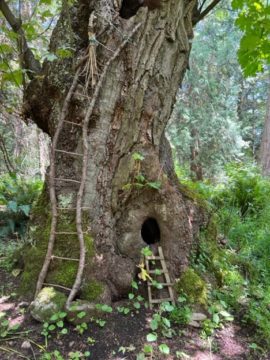
My property on Pender Island is just a postage stamp of a lot by rural standards, but the immensity of the surrounding stillness of the Pacific rainforest feels more precious to me than the numbers representing its square footage. With no other human dwellings within sight or hearing, the stillness is the silence of a cathedral in these weeks before Christmas, with the murmurs of devoted parishioners replaced by the soft chatter of Pacific wrens among the sword ferns, the nasal queries of a red-breasted nuthatch marching down a fir trunk, the gravelly chuckle of a raven passing overhead, and the slow creaking of an antique carriage clock being rewound deep in a cedar—the winder being a Pacific chorus frog perilously close to dormancy on a day threatening a hard frost. Much less audible, high in the canopy, are the whisperings of the tiny insect-hunters and seed-eaters that depend on the treetops for food: chestnut-backed chickadees, golden-crowned kinglets, pine siskins.
In this part of the world, on this island in the Salish Sea, the trees grow very large indeed. The aptly named grand firs may reach 250 feet and Douglas-firs are frequently taller, over 300 feet in some cases. In height though not in majesty they overshadow the western red cedars and bigleaf maples that dominate the glade in which my cabin stands, a quarter mile from the Canadian edge of Haro Strait and within hearing of the largest of the massive container ships struggling against the incoming tide.
Every tree has its own character. Outside the cabin stands a massive bigleaf maple (Acer macrophyllum) that has been through the wars but has risen again to defy the next winter storm. From time to time she drops branches as big as smaller trees (I have watched them fall) yet still carries on like some old limbless veteran, surviving by sheer will despite gaping holes in her trunk that delight children with supple imaginations. Why I call her she I do not know, but that is how she speaks to me. This forest glade seems always calm no matter how wild the storm, and I attribute that in large part to the maple that oversees the glade. Perhaps she meditates. I generally steer clear of anthropomorphism, but I feel her benevolent presence even while not clearly understanding it. And so she stands at the edge of winter, having for the last couple of months let fall dinnerplate-sized leaves that land with an audible thud, leaving her heavy branches bare and seemingly lifeless. But give that maple just a whiff of spring and she will respond, as she always does, a myriad of her seedlings bursting through last year’s fallen maple leaves, now decayed just enough to nourish the seedlings of the mother tree. Most will never make it past infancy, but one is all it takes. First Nations people in centuries past knew well the yearly pattern of bigleaf maples and planted their seeds to harvest the nutritional shoots, just as some people today sprout pea shoots or alfalfa. Later in the spring the tree’s lantern-like flowers will appear to glow in the shadows before releasing pale green clouds of pollen drifting through the air of the glade.
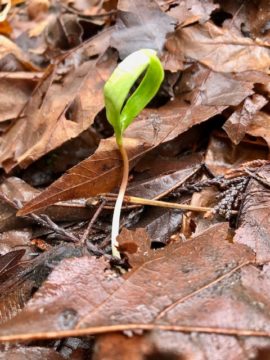
By far the dominant tree species in my glade is the western redcedar (Thuja plicata), for which the growing conditions are ideal: moist soil with a high water table. Cedars are dwarfs compared to the firs, rarely reaching 200 feet in height, but what they lack in height they make up in stature and character. Once in Clayoquot Sound I circumnavigated a Meares Island specimen as wide at the base as an average house, with smaller trees of other species growing out of its massive branches. Small wonder that First Nations considered the cedar the tree of life, with no part wasted. Whole trunks were carved into dugout canoes and totem poles; planks became the walls of longhouses or bentwood boxes; the fibrous bark was twisted into rope or woven into clothing.
Sink an axe into a round of cedar and it splits as easily as slicing a pound of butter, whether for roof shakes or woodstove kindling. Renowned for its resistance to decay, mature cedar was highly prized as well by the forest industry after the land was summarily removed from the control of indigenous peoples. Nowadays, the prohibitively high price of cedar reflects in large part the scarcity of old-growth cedar after a century of intensive harvesting.
The cabin was originally built in the 1950s, a one-room affair without power or plumbing. But the earliest sign of human activity on the lot is from a generation earlier, perhaps around 1910—the remnant of a western redcedar felled by two stout fellows with a crosscut saw. First they would have surveyed the giant trees around them before selecting one that was tall and straight. With their axes, they would have cut a wedge-shaped notch on either side of the cedar, deep and wide enough to accommodate the springboards on which they then stood, on opposite sides of the trunk, to wield the saw.
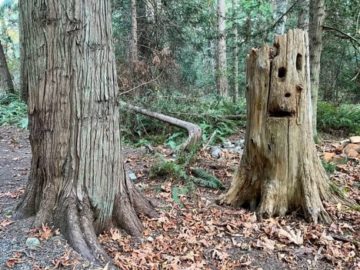
It would have been over in less than an hour, a 300-year-old cedar toppled for boardwood at a time when cedar was cheap and plentiful.
Today the cedar stump, still more or less unblemished after these hundred years, wears an enigmatic expression as if still wondering whatever happened that day so very long ago. Close by, on another part of the lot, a Douglas-fir trunk a good five feet in diameter, fallen many decades ago, is now a nurse log for cedar and fir seedlings that found a footing in the fallen giant’s bark. In a natural ecosystem, everything nourishes something else.
Those two loggers, unlike their stump, are long gone. They were barely a generation removed from the first white settler to take up residence on the island back in 1886, and no doubt considered themselves thoroughly modern. Patriotic too, of course, and eager to defend their fresh young country. They might have gone off to fight in the Great War with the other Pender Island boys but were likely too long in the tooth to volunteer for its ugly successor. Meanwhile, the W̱SÁNEĆ indigenous people who had called the island SDȺY¸ES and known it as home for thousands of years had been sent to distant reserves by the colonial government, forbidden to follow their nomadic lifestyle as “saltwater people” or to practice livelihoods such as the reefnet fishery that were seen to compete with white enterprises.
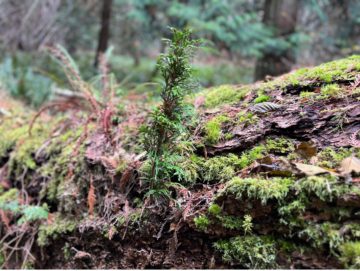
The modern equivalent of the two loggers, the generation of their great-grandchildren, chop wood on Pender Island for a very different purpose. These are the Green Angels, a group of men who labor not for a forest company but for their own satisfaction and the good of the community. Here’s how it works: a landowner has had some trees felled; the Green Angels buck the felled trees into rounds that they then split into firewood to be delivered to islanders on a waiting list. The islanders pay a market value for the wood, the owner of the property from which the wood came obtains a tax-deductible charitable donation receipt; the proceeds go to the island medical clinic or school projects or the community hall or to ordinary people in need, and the Green Angels obtain the satisfaction of a job well done and a good workout to boot—community spirit at its best and a good reminder that there’s more to an honest day’s work than personal gain. Many islanders have gone green and replaced fossil fuel energy sources and greedy electric baseboards with more economical and energy-efficient heat pumps, but when the power goes out, as it often does on an island with tall and sometimes diseased trees prone to keeling over, the old woodstove is a welcome backup.
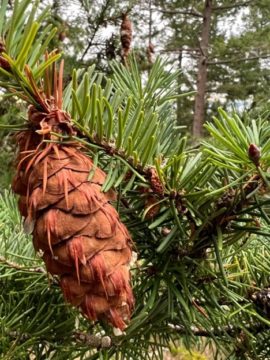
Douglas-fir (Pseudotsuga menziesii) is the usual stock in trade for the Green Angels. Grand fir (Abies grandis) gets punky (soft) so quickly it’s considered virtually worthless, and red alder (Alnus rubra) isn’t a whole lot better. Cedar sells well for ideal kindling but burning it in log form would be a waste. The tree of life deserves more respect than that. Grand fir and alder you might call the trees of death. They live fast and die young, and so are naturally male, the James Deans and Jim Morrisons of the rainforest. Grand fir grows a mile a minute then topples over when you least expect it, its shallow root ball no match for the moist conditions on this part of the island, and woe betide any forest cabin or hydro line that happens to lie in the path of a woody specimen a hundred feet or more from tip to toe.
Alder doesn’t topple over, it buckles in messy chunks that drop deadweight to the ground, or just stands limbless and full of holes for a few years, a meal for grubs and hence a regular destination for pileated woodpeckers and northern flickers. Once a pileated woodpecker starts its Charlie Watts routine, the whole silent cathedral metaphor goes out the window, though any creature that protects its noggin from drumming vibration damage by wrapping its tongue around its brain deserves a modicum of respect. Never doubt the capacity of natural selection to come up with creative solutions to challenging problems.
Finally there’s the arbutus (Arbutus menziesii), also known as the madrone, a tree quite unlike the others. Instead of growing straight towards the sky, it rambles and snakes in unpredictable diversions. Its paperlike bark is a brilliant reddish shade—except when it’s a brilliant green after the tree sheds its old skin in midsummer. A broad-leafed evergreen related to the rhododendron, the arbutus stays green through the winter but discards leaves periodically throughout the year, so that in August it may have the appearance of bearing bright yellow bananas among the green. Its smooth and bulging branches seem a passable imitation of muscular arms, and the tree produces breastlike protuberances as if on a whim, for no apparent purpose.
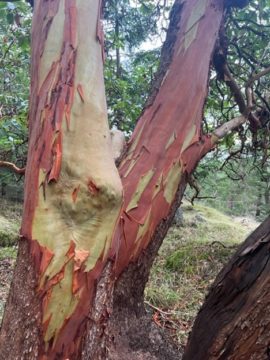
And if Christmas approaches and you’re short of holly, a sturdy arbutus branch will provide red berries to your heart’s content, if the robins haven’t beaten you to it. Its unabashed flamboyance looks out of place in the subdued north Pacific forest; it seems to belong somewhere warm like the Canary Islands (it grows there too) rather than overlooking the Salish Sea, even though the climate here is generously described as Mediterranean. A gang of meandering arbutus looks over my cabin like dancers extending an invitation, and it’s hard to resist spending regular time in their company.
All things must pass, and the forest composition is no exception. Humans live a mayfly existence compared to the western redcedar, which is capable of surviving over a thousand years in ideal conditions. Today there are ominous signs that my little half acre of trees may look very different a century from now. As usual with biodiversity impacts, humans are likely to blame in part, though not entirely in this case. Douglas-firs in the region are falling prey to the root disease caused by the deadly fungal pathogen Armillaria ostoyae. Cedars suffer increasing levels of stress as a result of lengthy periods of the drought that accompanies climate change. Arbutus forests are under attack not only by fungal infection but also by expanding populations of (predatorless) black-tailed deer, which strip the life out of arbutus saplings. Islanders who would welcome the reintroduction of cougar remain, sadly, in the minority. Which tree species will survive the coming century in this region and which will disappear remains anyone’s guess at the moment.
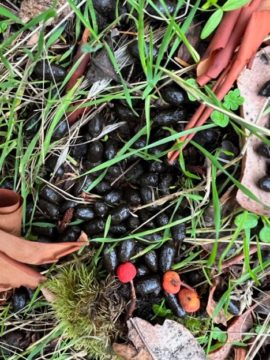
Years ago I played my own small role in introducing non-native, though not invasive, tree species into my plot of land. First came the fig tree, fenced off from deer in my vegetable garden. I planted a bay tree not with “tree” in mind but only as a two-foot shrub that I expected to maintain its diminutive size while providing flavoring when needed. The mutsu apple was a fairly recent addition that I planted with fond visions of apple strudel dancing in my head.
The fig and apple, unsurprisingly, turned out not to be lovers of cathedrals. I should have known they were both sun worshippers. They recorded their protest by remaining fruitless. My neighbor Ken, he of the sunny orchard, has kindly agreed to rescue them, and they seem happy to hear it. In truth, though, I had an ulterior motive for giving them away—they block the view of the cedars and firs. You could call it rewilding, I suppose, but for selfish, aesthetic reasons. The apple and fig no more belong there than cattle belong in a cathedral, with all due respect to Herefords. For similar reasons I have removed all semblances of fences, garden or otherwise, in the spirit of Robert Frost’s line, “Something there is that doesn’t love a wall.”
The bay tree, not content with being a measly shrub, has matured into a healthy specimen twenty-five feet high and almost as wide. It now overhangs the cabin roof. It’s most threatened by the young bucks (those black-tailed deer again) who rub their antlers against its trunk to remove the velvet and in the process carve a substantial gash in the bay tree’s bark, which I have now protected. I suppose that to fully achieve rewilding I should give the bay tree away as well, but I reason that it should be properly grouped with herbs like tarragon and thyme and rosemary. I’ve decided to make a rewilding exception for herbs and, really, what is a bay tree but a herb with glossy leaves?
***
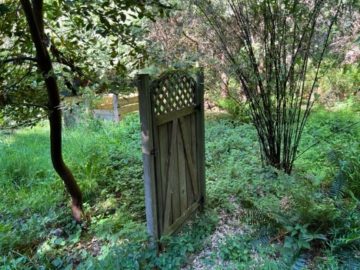
Thanks to Robin Harvey for the photo of a cedar seedling on a Douglas-fir nurse log.
